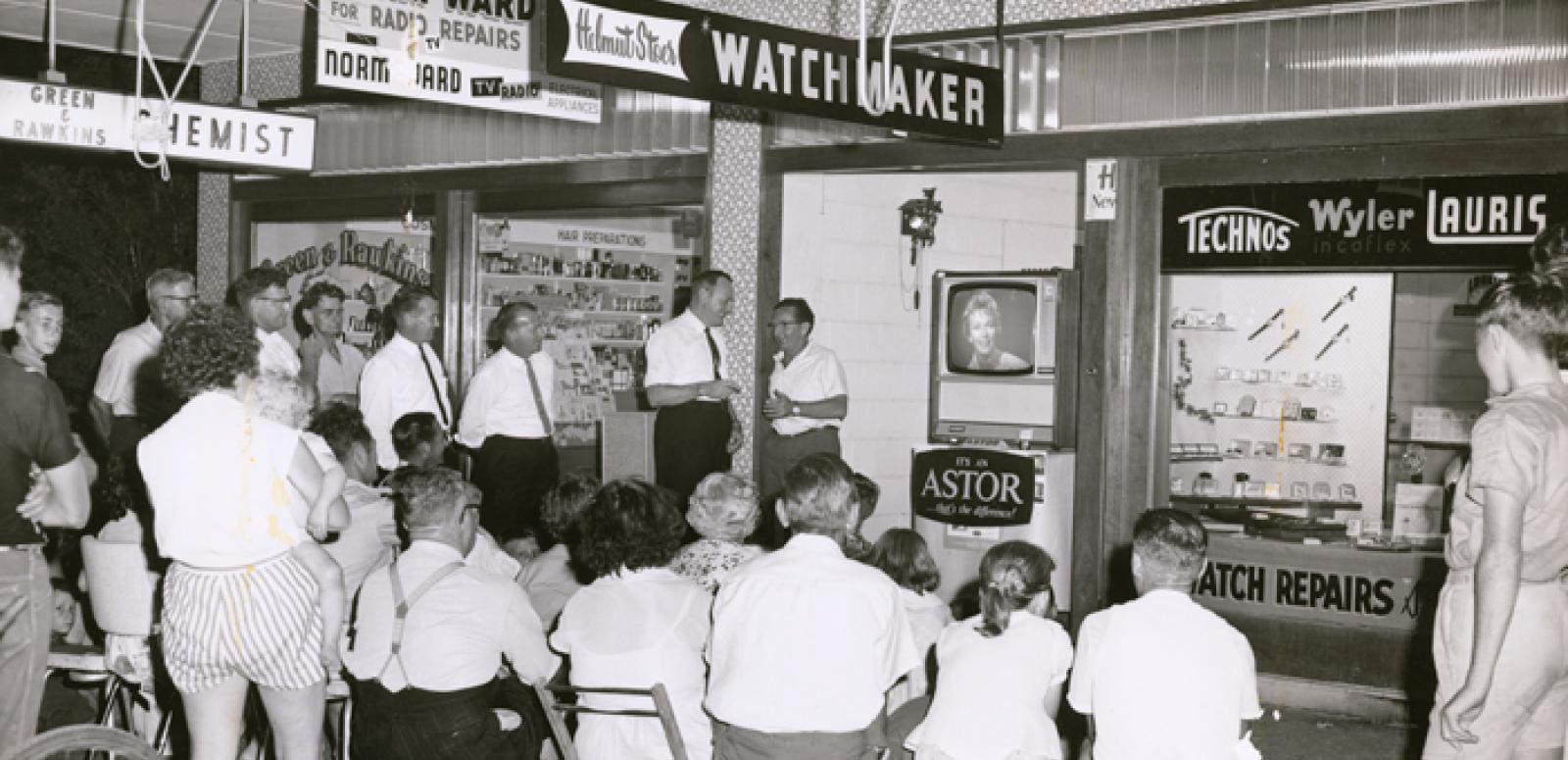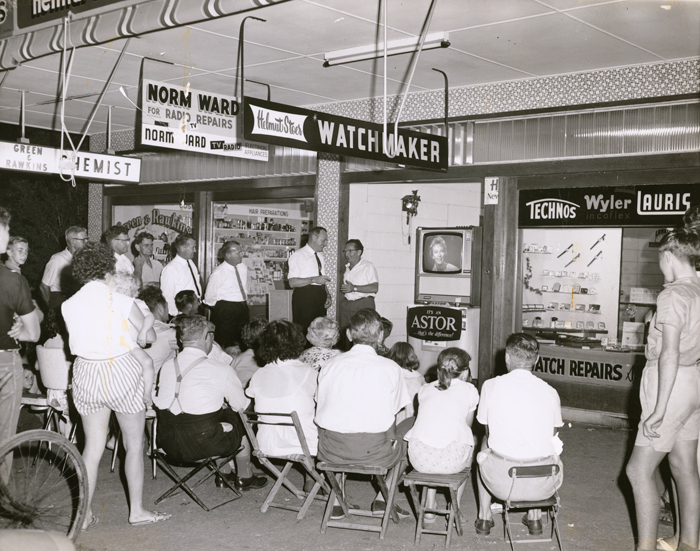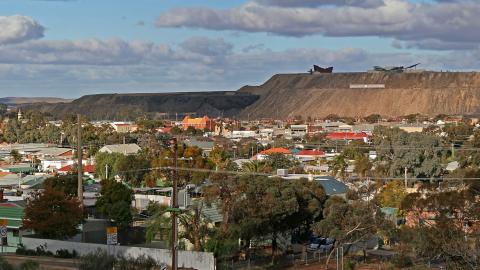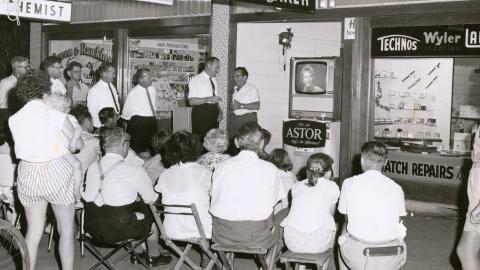

Regional TV in Australia
Regional TV in Australia
It was in 1961 and 1962 that people living in regional areas on the east coast of Australia received television for the first time. Others had to wait a little longer; it would be another 15 years before the last of the regional stations, GTW 11 Geraldton, would open.
By exploring the NFSA collection we are able to get an insight into regional television – the challenges, partnerships and stories behind bringing television to Australia’s country areas. See also Regional TV: Colour to Digital.
The first 12 regional stations
- GLV 10 Gippsland – 9 December 1961
- BCV 8 Bendigo – 23 December 1961
- GMV 6 Shepparton – 23 December 1961
- NBN Newcastle – 4 March 1962
- CBN 8 Orange – 17 March 1962
- WIN 4 Wollongong – 18 March 1962
- BTV 6 Ballarat – 27 April 1962
- RTN 8 Lismore – 12 May 1962
- TNT 9 Launceston – 26 May 1962
- CTC 7 Canberra – 2 June 1962
- DDQ 10 Toowoomba – 13 July 1962
- TNQ 7 Townsville – 1 November 1962
Keeping it local
The story begins in earnest on 30 April 1959 when Postmaster-General CW Davidson announced that the Government would be calling for applications for licences for Phase 3 of television development in the provincial areas of Canberra, Wollongong, Newcastle, Orange, Launceston, Ballarat, Bendigo, Shepparton, Traralgon, Townsville, Toowoomba, Lismore and Rockhampton. The Australian Broadcasting Control Board then called for applications on 21 May 1959 and began hearing submissions from local business and community groups in the regions on 10 November 1959.
According to George Barlin, the first General Manager of CTC 7 in Canberra, in his book 25 Years of an Almost Impossible Dream (c1987), 'The Postmaster-General had advised that as far as practicable "preference would be given to applicants which are local independent companies not associated with metropolitan stations"‘. The two Sydney metropolitan television stations, TCN 9 and ATN 7, presented a United States-based model:
George Barlin, first General Manager of CTC 7 Canberra, discusses television licences (c2002). Courtesy: Southern Cross Austereo. NFSA: 570569
Indeed, when the licences were issued, they all went to local companies.
Successful applicants came largely from radio and newspaper backgrounds. They had intimate knowledge of the value of independence and an active role in their local communities. They also firmly believed that the people from these communities should be able to have ownership of their station so, when forming their television companies, offered shares to residents of the area.
As regional television evolved, this theme was still strong, as Jack Gleeson, Managing Director of NQTV, was proud to announce in his speech at the opening of the North Queensland Television and Radio Centre in 1978:
Jack Gleeson, Managing Director of NQTV, talks about local shareholders in the TV company in his speech at the opening of the North Queensland Television and Radio Centre in 1978. Courtesy: Southern Cross Austereo. NFSA: 409182
Localism was felt keenly in country areas. By the time the residents of the Eden-Monaro and Cooma area received television through CTC 10 (on relay from CTC 7 Canberra) in 1966, television was seen as being able to play a vital role – that of enabling decentralisation and keeping country kids in the country:
Steve Major, Member of Legislative Assembly representing Eden-Monaro, talks about the role of television in decentralisation in a speech for the opening of CTC 10 Cooma in 1966. Courtesy: Southern Cross Austereo. NFSA: 54082
Even in 1978 at the opening of the new NQTV Radio and Television Centre in Townsville, Jim Malone, Federal Director of FACTS, spoke of the importance of television in reflecting local, national and international perspectives:
Jim Malone, Federal Director of FACTS, talks about the important role of television in the community during his speech at the opening of the North Queensland Television and Radio Centre in 1978. Courtesy: Southern Cross Austereo. NFSA: 409182
In bringing the experience of overseas lifestyles to local communities, the licence applicants had to find a way to finance the importation and distribution of overseas programs, the costs of which were largely beyond the capabilities of many of the stations. So applicants from the different regions joined together to form Australian Television Facilities Pty Limited (ATF).
ATF would run a film exchange, make bulk purchases, organise group broadcast rights and, later, import equipment on behalf of the group of stations, to bring costs to a more realistic level. This partnership was to play a significant role in the allocation of licences. When the Postmaster-General announced the successful applicants on 8 November 1960, each was a member of the ATF.
An almost impossible dream
The granting of the licence was the first hurdle to be cleared in bringing television to regional areas, but some stations were to encounter problems in being able to build their transmission towers and, in CTC 7’s case, the station itself.
Having selected Black Mountain as being the most suitable site to provide the best signal to the residents of Canberra, CTC 7 ran into difficulties with the National Capital Development Commission (NCDC). Two of the NCDC’s concerns were the ‘erection of an "ugly" tower or towers’ and that ‘no large buildings would be permitted and any building to be erected had to be obscured from sight from central Canberra and not more than 20 feet [6.096 metres] high and of such external colour as to blend in with the mountain top’ (25 Years of an Almost Impossible Dream, GK Barlin).
Unfortunately television transmission towers are about 76.5 metres in height and the NCDC’s compromise of allowing the erection of a 6-metre high tower ‘provided we [CTC 7 and ABC, which was also starting broadcasting in Canberra at the same time] agreed to grow a creeper over it’ would not be suitable. Barlin goes on to say:
'Later, after the facts of TV life were explained we were told a "pencil" mast about 600 feet [183 metres] tall to be used by both stations would be approved provided it was painted green. When DCA’s [Department of Civil Aviation] requirements were quoted the standard orange and white configuration was agreed to.'
As to the erection of the studio:
George Barlin, first General Manager of CTC 7 Canberra, talks of tests conducted on Black Mountain to see if a building would be seen in the suburbs (c2002). Courtesy: Southern Cross Austereo. NFSA: 570569
CTC 7 General Manager George Barlin and Chairman of the Board Arthur Shakespeare in the bush on Black Mountain, Canberra, where Canberra’s first television studio and transmitter was to be located. Please note: This clip is silent. Courtesy: Southern Cross Austereo. NFSA: 568609
For TNQ 7 in Townsville, the government of the day had allocated Mt Elliot as the site for their transmission tower, however there were no roads or access to Mt Elliot and no helicopters in Townsville to carry the building materials and equipment up there.
The solution proposed to TNQ 7 was for the company to build accommodation for the staff on the mountain so they could live there for a week at a time.
The first regional broadcast
Six months after the successful applicants were announced, progress was well underway for most of the provincial stations; transmission towers and studios were being constructed, equipment purchased and staff hired.
The first station to broadcast was GLV 10 in Traralgon on 9 December 1961; the following footage records regional television’s auspicious beginnings:
The beginning of television in regional Australia (c1961). Please note: This clip is silent. NFSA: 778831
GLV 10 had already begun test transmissions by the time CTC 7 began construction of the transmission tower and studio on 26 September 1961. The keys to the station were finally received in early 1962:
The official handover of the keys to the CTC 7 studio on Black Mountain, Canberra. Please note: This clip is silent. Courtesy: Southern Cross Austereo. NFSA: 568609
True to their commitment to localism, the stations employed mainly local people, although key personnel who had worked in television at Australian metropolitan stations and overseas were also hired. It was these people who were able to train the local staff in television operations, whilst waiting for the construction of studios and the installation of equipment.
Since CTC 7 was behind other stations in the process, they were able to lend two technicians to RCA, the company that was supplying and installing equipment in other stations, including NBN Newcastle. The installation and operational experience the two CTC 7 technicians gained from working at NBN was invaluable when the Canberra station went on air.
A practical side to television coming to regional centres was getting people to buy television sets. To build anticipation some stations took out newspaper advertisements announcing the dates of test transmissions, and television set manufacturers also did their part. When TNQ 7 began their test transmissions in Townsville in 1962, Ron Harris, on behalf of Astor, joined forces with local electronics retailer Norm Ward:

Crowd watching test transmission on Astor Television at retailer Norm Ward’s, Townsville.
Ron Harris discusses his approach to promote Astor television sales in Townsville. NFSA: 806658
With so many locals interested in television, the stations approached local retailers about sponsorship of the test transmissions, with perhaps less success than Ron Harris! As CTC 7’s Bill Rayner tells it:
Bill Rayner, Sales Manager for CTC 7, talks about selling advertising on CTC7’s test transmissions in 1962. Courtesy: Southern Cross Austereo. NFSA: 570563
The openings
On the night of 9 December 1961, GLV 10 in Gippsland began transmission, bringing television to regional Australia. Opening night began at 5.45pm with the short film Touring Gippsland. At 6pm Don Ewart, an announcer at local radio station 3TR, introduced television to Gippsland; unfortunately his first words were not heard as his microphone wasn’t switched on.
The official opening was done by the Chairman of the Australian Broadcasting Control Board, RG Osborne. The opening was attended by entertainers Horrie Dargie, Bobby Limb, Happy Hammond and Johnny Chester.
Bobby Limb also attended the opening of GMV 6 Shepparton on 23 December 1961, the same day BCV 8 opened in Bendigo, and he appeared with Johnny O’Connor in the opening ceremony of CBN 8 Orange on 17 March 1962:
Michael Devine describes opening night on CBN 8 in Orange in the station’s 10th anniversary program, Ten Years of Progress. Courtesy: Prime7. NFSA: 441919
In 1962, the first country television station in NSW, NBN Newcastle, opened. On 4 March the opening ceremony included a recorded message from Postmaster-General CW Davidson, seen here as part of the NBN News story on the station’s 50th anniversary:
NBN celebrates 50 years during NBN News bulletin on 4 March 2012. Courtesy: NBN. NFSA: 1053704
When CTC 7 opened on 2 June 1962, Postmaster-General CW Davidson appeared in person to officially open the station:
Postmaster-General CW Davidson’s speech at the official opening of Canberra’s first television station on 2 June 1962. Courtesy: Southern Cross Austereo. NFSA: 568609
New competitors
In his speech, Davidson makes mention of the fact that he was taking a keen interest in television programming and how important good quality programs are to the success of both metropolitan and country television. He may have been alluding to an issue that was brewing between the two Sydney metropolitan stations ATN (John Fairfax Ltd – RAG Henderson) and TCN (Consolidated Press – Frank Packer) and what they considered their potential competitors in WIN 4 Wollongong and NBN Newcastle.
Many residents of these regions had been able to receive the Sydney stations’ signals and therefore watch their programs since 1956. It came to a head in 1963 when the two Sydney stations took action to deny WIN 4 Wollongong and NBN Newcastle access to programs, not only those produced by the two metropolitan stations, but also those from America.
American film distributors were informed that TCN and ATN would boycott if they sold programs to WIN 4 and NBN. The result was that WIN and NBN had access to fewer programs, and as many of their viewers were able to pick up the signals from ATN and TCN, the two country stations struggled financially due to reduced advertising opportunities.
Rupert Murdoch, then owner of NWS 9, Adelaide, was taking an interest in the events unfolding on the Australian east coast, flying to the United States and buying ‘new season’ rights for Australia to most of the programs running on TCN and ATN, as well as some new programs. He also bought a controlling interest in WIN 4, a substantial interest in NBN and significant interest in TCN.
The result was that the two metropolitan stations had to then deal with Murdoch in the purchase of broadcast rights for the American programming. Murdoch reserved country broadcast rights which he sold through ATF to regional stations, including WIN 4 and NBN. So from struggling financially, the two stations have gone on to thrive and grow.
Looking back – and forward
So how did WIN 4 Wollongong and NBN Newcastle share their 50th anniversaries with their viewers in 2012?
Looking back at 50 years of WIN Television in WIN News, Wollongong on 22 March 2012. Courtesy: WIN Television. NFSA: 1053702
Deborah Wright, NBN CEO, thanks viewers and all NBN employees in marking 50 years of television in Newcastle at the end of NBN News on 4 March 2012. Courtesy: NBN Television NFSA: 1053704
There have been many changes to the regional television landscape since 1962. More stations opened in South Australia, Western Australia and the Northern Territory and more regions received television on relay. The economic highs and lows of each region, combined with the continually increasing costs of keeping up with the latest television equipment and operations, has dictated the terms of sustainability for many of the stations.
In order to remain financially viable partnerships, mergers and demergers between stations occurred to form regional networks, until aggregation saw the formation of the free-to-air commercial regional networks, including NBN, WIN, Prime7 and Southern Cross Austereo.
Despite all these changes there is still the underlying commitment to retaining a sense of independence from the metropolitan networks and providing local productions and news to the communities that regional television continues to serve.
Executives inspect the building site for regional television’s first station, GLV 10 in Traralgon. Please note: This clip is silent. NFSA: 778831
This article was first published in 2012 and updated in 2022.
The National Film and Sound Archive of Australia acknowledges Australia’s Aboriginal and Torres Strait Islander peoples as the Traditional Custodians of the land on which we work and live and gives respect to their Elders both past and present.


